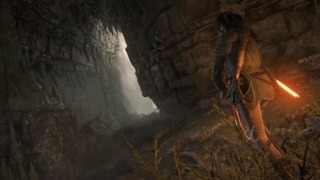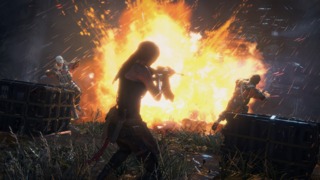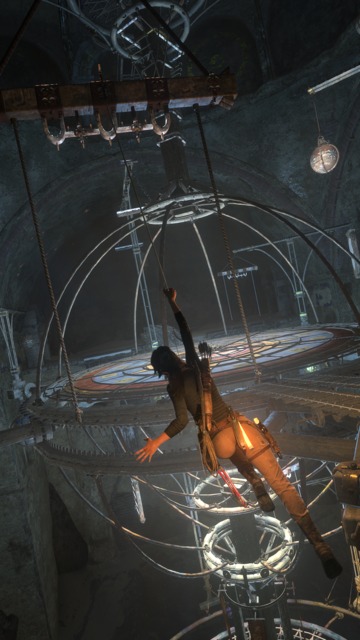Rise of the Tomb Raider is an apt name for a game that improves as much on its predecessor as this one does. The second outing for Crystal Dynamics' earnest reimagining of Lara Croft follows the same blueprint as 2013's reboot, which is to say there's a fair number of tightly scripted action set pieces and shootouts with heavily armed mercenaries in here. But then, my prevailing memory of the last (first?) Tomb Raider is of nothing but set pieces and shootouts. By contrast, this sequel cuts all that larger-than-life action with a more generous dose of side activities, a greater focus on exploration, and a deeper sense of wonder at the ancient ruins and myths you're uncovering. You know, some good old-fashioned tomb-raiding. It's a lengthy and gorgeous adventure with a lot of variety that represents a great step up from Crystal Dynamics' previous effort.

Rise's premise feels ripped straight from Indiana Jones, or the old pulp serials that inspired it, but the game handles its storytelling deftly enough that it's hard to care if it's all a little derivative. This sequel finds a more seasoned, confident Lara Croft chasing down a legendary artifact called the Divine Source in the mountains of Siberia, with the modern, militarized version of a shadowy ancient sect called Trinity hot on her heels. Lara's dad, the august Lord Croft, died in pursuit of the very same artifact, and the game interweaves some flashbacks and a little pining for his life's work into the quest in a way that isn't hackneyed or overbearing. More importantly, Lara's clashes with fanatical Trinity operatives and her dealings with the mountainous region's mysterious locals provide for some fun twists and turns that aren't much less satisfying even when you see a few of them coming. In contrast to the first game, which had you murdering mercs by the dozens and then abruptly remembered to go "oh hey supernatural stuff!" in the last third, this game creates a more slow-and-steady build toward its mystical reveals that makes them more enjoyable when they inevitably happen. The story beats feel a little more earned here than they did in the last game, partly because a good bit of the flavor text that appears in collectibles and even overheard dialogue successfully builds up and contextualizes all the people you're chasing and secrets you're uncovering.
The new game has a nice sense of pacing. The story routinely sends you through 30 minutes to an hour of tense, tightly designed climbin'-and-shootin' sequences in linear, constrained areas--the stuff you expect from this kind of big-budget thrill ride--and then right around the point when you feel like it's time for a break, it pops you back out into one of a handful of expansive hub areas that are chock-full of shorter, less urgent activities. The first game toyed with the idea of wider levels that consisted of more than a single linear path toward the exit, but it didn't go far enough; there wasn't much to do in those places besides hunt for a few collectibles you'd missed. Here, the hub zones almost feel like little open-world maps unto themselves. Each one has a huge number of items and challenges to find, a collection of real live quest-givers (!) who dispense side missions (!!), and a handful of honest-to-god tombs (!!!) whose depths you may plumb at your leisure. The hubs also house a number of friendly NPCs who you can run up to and chat with, to get some extra story detail. It all works well enough to make me wonder what a truly open-world Tomb Raider from this developer could be.
Doing all this side stuff felt worthwhile on its own merits, because the activities are all fun to engage with and because I like checking off video-game to-do lists. But the side missions and collectibles really feel relevant to the gameplay as well, since they all feed into an expanded version of the crafting and skill progression from the previous game. Generic collectibles like relics and logs earn you experience that feed your talent tree. Better weapons and attachments are scattered among the other collectibles. And the game's "challenge tombs" in particular each grant you a highly useful, unique skill you can't get otherwise. They're also where you'll find the highest density of ancient machinery to climb on and manipulate (and they mostly look really cool to boot). The antique scenery isn't relegated to the side tombs, either; the game is good about filling its critical story path with these kinds of big stone clockwork puzzles, as well. By the time I'd finished the lengthy Syrian tutorial area, I already felt like I'd discovered more intricate ruins than in the entirety of the previous game. Exploring and solving the forgotten secrets of some wise, vanished civilization is what I'm showing up for when I play a game called Tomb Raider, so it was a delight that Rise is more satisfying than its predecessor in that regard.

Maybe it's my generally short attention span, but Rise's huge amount of variety in activities and challenges--and specifically the way it constantly doles out and gives you access to new tasks to accomplish--meant I spent nearly all my free time after I got a hold of this game playing it somewhat obsessively, attempting to hit 100 percent completion in each area. But you'll quickly realize you can't max out each area up front, because the designers are totally unafraid to get their Metroid on, frequently showing you new pathways you can't pursue until you acquire rope arrows, a grappling hook, underwater breathing equipment, or some other piece of survival gear. Valuable upgrades and some of the most interesting side content, like several of the challenge tombs, are locked up behind these sorts of barriers, so every time you get some new ability upgrade your mind will immediately call back to all those new places you can now go check out. The campfires that let you fast travel around are back from the first game, so it's easy to go back and get just about everything you missed, if you feel like it. I thought it was a really nice touch that the time of day now changes in each region when you go back, adding some much-appreciated variety to the atmosphere, and old areas are repopulated with more enemies to fight and animals to hunt. All that helps make the world feel more dynamic and lived-in, so it's a little less lonely and rote when you go back to clear out old areas.
There's still plenty of combat to plow through here, though fighting bad guys in tactical gear doesn't quite feel like it forms the entire backbone of the game like it did before. And luckily, most combat encounters feel more dynamic and improvisational this time around, since you have some nicely expanded options in the stealth-kill and crafted-weapon categories. You're just as likely to descend on an enemy from a tree branch for a silent stealth kill, or grab a bottle and craft it into an on-the-fly Molotov cocktail, as you are to hide behind a crate and pop up to squeeze off a few headshots. You still do plenty of that too, but there are also some interesting late-game shooting abilities, mainly to help you counter more powerful enemies with shields and armor and such, that keep things feeling fresh. Despite all these improvements, the basic aiming and shooting still feels slower and more awkward here than I'd like, which seems to be a combination of slightly sluggish controls and a sometimes uneven frame rate.

Owing largely to the amount of optional content, Rise of the Tomb Raider is a shockingly lengthy game. Even the core storyline feels longer than average for this kind of big-publisher blockbuster, but if you add in all the side content and backtracking, you're really going to be here for a while. The system-level clock on my Xbox One sat at 42 hours when I finished the game, some of which was due to letting the game idle at the pause menu and producing video content, but I'd guess I put a minimum of 30 hours of actual playtime into the game, maybe more. For total completionists, thankfully the achievements are largely geared toward goofing around in the world rather than forcing you to find every single last collectible (you only need to get most of them), and after the story is over there's even a little narrative justification to smooth over the fact that you can pop back out into the world and keep fighting and collecting. I wouldn't have complained about one or two more hub areas simply because they're so satisfying to explore, but it's hardly like the game is short on length and value.
This is also a truly gorgeous game, through some grand and sweeping uses of dramatic lighting, a lot of really impressive character animation for Lara Croft as she swings, climbs, crawls, and leaps around, and just by virtue of the sheer range and complexity of the exotic environments on offer. As acrobatic as Lara is, some of the character animations can look a little awkward transitioning from one to another, and I saw some enemies bug out here and there while trying to traverse different parts of the level geometry. The Xbox One version of the game is conspicuously the only one releasing at launch, and while it's totally playable across the board and smooth enough in general, the performance was less than ideal in a couple of environments in particular, in a way that didn't live up to the sheer splendor of the visual design. If you're invested in playing this game and don't want to wait, get the Xbox version right now. But if you aren't in a huge hurry, this game should be a real looker on a well-equipped PC in a handful of months, assuming all goes well with that version.
Nothing about Rise of the Tomb Raider is wildly original, but everything about it is executed with a high degree of quality and craft. The game nicely merges multiple styles of gameplay, tells a better story than the 2013 reboot, and leaves off with Lara Croft at the center of an expanding narrative universe that feels like it could become home to many more exciting adventures. The last game was a decent start, but for my money, this is where the new Tomb Raider really begins.